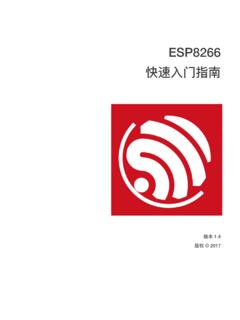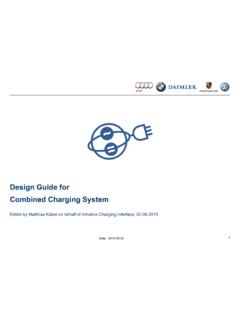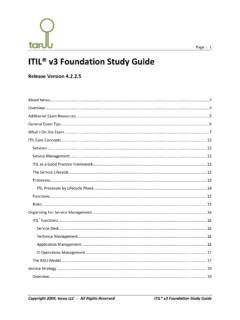Transcription of Hardware Design Guidelines - Espressif
1 ESP32 Hardware Design GuidelinesVersion SystemsCopyright This DocumentThe Guidelines outline recommended Design practices when developing standalone or add-on systems based onthe ESP32 series of products, including ESP32 SoCs, ESP32 modules and ESP32 development UpdatesPlease always refer to the latest version HistoryFor the revision history of this document, please refer to thelast Change NotificationEspressif provides email notifications to keep customers updated on changes to technical documentation. Pleasesubscribe Note that you need to update your subscription to receive notifi-cations of new products you are not currently subscribed certificates for Espressif products Overview12 Schematic Power Digital Power Analog Power Power-on Sequence and System Power-on Flash (compulsory) and PSRAM (optional) Crystal External Clock Source (compulsory) RTC (optional) External Touch Sensor103 PCB Layout Standalone ESP32 General Principles of PCB Positioning an ESP32 Module on a Base Power Crystal Flash & External Touch ESP32 as a Slave Typical Layout Problems and Q: The current ripple is not large, but the TX performance of RF is rather Q.
2 The power ripple is small, but RF TX performance is Q: When ESP32 sends data packages, the power value is much higher or lower than the targetpower value, and the EVM is relatively Q: TX performance is not bad, but the RX sensitivity is Hardware Development235 ESP32 Smart Audio ESP32-LyraT Audio Development ESP32-LyraTD-MSC Audio Development ESP32 Touch Sensor Application ESP32-Sense ESP-Mesh Application ESP32-MeshKit27 Revision History28 List of Figures1 ESP32 Schematics (ESP32-D0WD used as an example for all illustrations in this section)22 ESP32 Digital Power Supply Pins33 ESP32 Analog Power Supply Pins44 Connections of ESP32 with Flash and PSRAM65 ESP32 Crystal Oscillator66 Schematic for ESP32 s External Crystal (RTC)77 Schematic of External Oscillator88 ESP32 RF Matching Schematics89 ESP32 External Capacitor910 ESP32 UART911 ESP32 PCB Layout1112 ESP32 Module Antenna Position on Base Board1213 Keepout Zone for ESP32 Module s Antenna on the Base Board1314 ESP32 Power Traces in a Four-layer PCB Design1415 Nine-Grid Design for EPAD1416 ESP32 Power Traces in a Two-layer PCB Design1517 ESP32 Crystal Oscillator Layout1618 ESP32 RF Layout in a Four-layer PCB Design1719 ESP32 RF Layout in a Two-layer PCB Design1720 ESP32 Flash and PSRAM Layout1821 ESP32 UART Design1822 A Typical Touch Sensor Application1923 Electrode Pattern Requirements1924 Sensor Track Routing Requirements2025 PAD/TV Box Layout2126 Top View of ESP32-LyraT2427 Bottom View of
3 ESP32-LyraT2528 ESP32-LyraTD-MSC2629 ESP32-Sense Kit2630 ESP32-MeshKit-Light 2731 ESP32-MeshKit-Sense Development Board271. is a single GHz Wi-Fi and Bluetooth combo chip designed with TSMC ultra-low-power 40 nm technol-ogy. It is designed to achieve the best power and RF performance, robustness, versatility, and reliability in a widevariety of applications and different power is a highly-integrated solution for Wi-Fi + Bluetooth applications in the IoT industry with around 20 externalcomponents. ESP32 integrates the antenna switch, RF balun, power amplifier, low noise receive amplifier, filters,and power management modules. As such, the entire solution occupies minimal Printed Circuit Board (PCB) uses CMOS for single-chip fully-integrated radio and baseband, and also integrates advanced calibrationcircuitries that allow the solution to dynamically adjust itself to remove external circuit imperfections or adjust tochanges in external conditions.
4 As such, the mass production of ESP32 solutions does not require expensive andspecialized Wi-Fi test ESP32 series of chips includes ESP32-D0WD-V3, ESP32-D0 WDQ6-V3, ESP32-D0WD(NotRecommendedForNewDesigns), ESP32-D0 WDQ6(NotRecommendedForNewDesigns), ESP32-S0WD, and ESP32-U4 WDH,among which, ESP32-D0WD-V3, ESP32-D0 WDQ6-V3, and ESP32-U4 WDH are based on ECO V3 wafer. Fordetails of part number and ordering information, please refer toESP32 Series Datasheet. For details on ECO V3instructions, please refer toESP32 ECO V3 User Systems1 SubmitDocumentationFeedbackESP32 Hardware Design Guidelines SCHEMATIC ChecklistESP32 s integrated circuitry requires only 20 resistors, capacitors and inductors, one crystal and one SPI flash integrates the complete transmit/receive RF functionality including antenna switches, RF balun, power am-plifier, low noise receive amplifier, filters, power management module, and advanced calibration s high integration allows for simple peripheral circuit Design .
5 This chapter details ESP32 schematics andPCB layout Design . ESP32 schematic is shown in capacitance of C1 and C2 varieswith the selection of the NumberRevDate:Sheetof<Doc>ESP-WROOM-32-5X5A211 Tuesday, July 03, 2018 TitleSizeDocument NumberRevDate:Sheetof<Doc>ESP-WROOM-32-5X5A211 Tuesday, July 03, 2018 TitleSizeDocument NumberRevDate:Sheetof<Doc>ESP-WROOM-32-5X5A211 Tuesday, July 03, (5%)C1310uFU3 FLASH/CS1DO2/WP3 GND4DI5 CLK6/HOLD7 VCC8J30 CON11J23 CON11C510 (10%) (10%) ANT12C16270pF(NC)J7 CON11J25 CON11J21 CON11J6 CON11J33 CON11J17 CON11J32 CON11C17270pF(NC)J10 CON11J1 CON11J15 CON11J3 CON11J24 CON11J37 CON11J27 CON11J2 CON11U2 ESP32-D0 WDVDDA1 LNA_IN2 VDD3P33 VDD3P34 SENSOR_VP5 SENSOR_CAPP6 SENSOR_CAPN7 SENSOR_VN8 CHIP_PU9 VDET_110 VDET_21132K_XP1232K_XN13 GPIO2514 GPIO2615 GPIO2716 MTMS17 MTDI18 VDD3P3_RTC19 MTCK20 MTDO21 GPIO222 GPIO023 GPIO424 VDD_SDIO26 GPIO1625 GPIO1727SD_DATA_228SD_DATA_329SD_CMD30SD _CLK31SD_DATA_032 GND49SD_DATA_133 GPIO534 GPIO1835 GPIO1938 CAP247 VDDA43 XTAL_N44 XTAL_P45 GPIO2336U0 TXD41 GPIO2239 GPIO2142 VDD3P3_CPU37 CAP148 VDDA46U0 RXD40C201uFL4 TBDC1 TBDC181uFJ20 CON11J16 CON11J5 CON11C12 NCU140 MHz+ 1: ESP32 Schematics (ESP32-D0WD used as an example for all illustrations in this section)Any basic ESP32 circuit Design may be broken down into 10 major sections.
6 Power supply Power-on sequence and system reset Flash and PSRAM (optional) Crystal oscillator RF ADC External capacitors UART SDIO Touch SensorEspressif Systems2 SubmitDocumentationFeedbackESP32 Hardware Design Guidelines SCHEMATIC SupplyForfurtherdetailsofusingthepowersu pplypins, pleaserefertoSectionPower SchemeinESP32 Series Power SupplyPin19 and pin37 are the power supply pins for RTC and CPU, respectively. The digital power supply operates ina voltage range of V~ V. We recommend adding extra filter capacitors of F close to the digital powersupply (pin26) works as the power supply for the related IO, and also for an external device. When VDD_SDIO operates at V, it can be generated from ESP32 s internal LDO. The maximum currentthis LDO can offer is 40 mA, and the output voltage range is V~ V.
7 When the VDD_SDIO V, the value of GPIO12 should be set to 1 when the chip boots and it is recommended that users add a2 k ground resistor and a F filter capacitor close to VDD_SDIO. When VDD_SDIO operates at V, it is driven directly by VDD3P3_RTC through a 6 resistor, therefore,there will be some voltage drop from VDD3P3_RTC. When the VDD_SDIO outputs V, the value of GPIO12is 0 (default) when the chip boots and it is recommended that users add a 1 F capacitor close to can also be driven by an external power supply. The schematic for ESP32 digital power supply pins isshown in capacitance of C1 and C2 varieswith the selection of the NumberRevDate:Sheetof<Doc>ESP-WROOM-32-5X5A211 Tuesday, July 03, 2018 TitleSizeDocument NumberRevDate:Sheetof<Doc>ESP-WROOM-32-5X5A211 Tuesday, July 03, 2018 TitleSizeDocument NumberRevDate.
8 Sheetof<Doc>ESP-WROOM-32-5X5A211 Tuesday, July 03, (5%)C1310uFU3 FLASH/CS1DO2/WP3 GND4DI5 CLK6/HOLD7 VCC8J30 CON11J23 CON11C510 (10%) (10%) ANT12C16270pF(NC)J7 CON11J25 CON11J21 CON11J6 CON11J33 CON11J17 CON11J32 CON11C17270pF(NC)J10 CON11J1 CON11J15 CON11J3 CON11J24 CON11J37 CON11J27 CON11J2 CON11U2 ESP32-D0 WDVDDA1 LNA_IN2 VDD3P33 VDD3P34 SENSOR_VP5 SENSOR_CAPP6 SENSOR_CAPN7 SENSOR_VN8 CHIP_PU9 VDET_110 VDET_21132K_XP1232K_XN13 GPIO2514 GPIO2615 GPIO2716 MTMS17 MTDI18 VDD3P3_RTC19 MTCK20 MTDO21 GPIO222 GPIO023 GPIO424 VDD_SDIO26 GPIO1625 GPIO1727SD_DATA_228SD_DATA_329SD_CMD30SD _CLK31SD_DATA_032 GND49SD_DATA_133 GPIO534 GPIO1835 GPIO1938 CAP247 VDDA43 XTAL_N44 XTAL_P45 GPIO2336U0 TXD41 GPIO2239 GPIO2142 VDD3P3_CPU37 CAP148 VDDA46U0 RXD40C201uFL4 TBDC1 TBDC181uFJ20 CON11J16 CON11J5 CON11C12 NCU140 MHz+ 2: ESP32 Digital Power Supply PinsNotice.
9 When using VDD_SDIO as the power supply pin for the external V flash/PSRAM, the supply voltage shouldbe V or above, so as to meet the requirements of flash/PSRAM s working Systems3 SubmitDocumentationFeedbackESP32 Hardware Design Guidelines SCHEMATIC Power SupplyPin1, pin3, pin4, pin43 and pin46 are the analog power supply pins. It should be noted that the sudden increasein current draw, when ESP32 is in transmission mode, may cause a power rail collapse. Therefore, it is highlyrecommended to add another 10 F capacitor to the power trace, which can work in conjunction with the Fcapacitor. LC filter circuit needs to be added near the power pin so as to suppress high-frequency inductor s rated current is preferably 500 mA and schematic for ESP32 analog power supply pins is shown in capacitance of C1 and C2 varieswith the selection of the NumberRevDate:Sheetof<Doc>ESP-WROOM-32-5X5A211 Tuesday, July 03, 2018 TitleSizeDocument NumberRevDate:Sheetof<Doc>ESP-WROOM-32-5X5A211 Tuesday, July 03, 2018 TitleSizeDocument NumberRevDate.
10 Sheetof<Doc>ESP-WROOM-32-5X5A211 Tuesday, July 03, (5%)C1310uFU3 FLASH/CS1DO2/WP3 GND4DI5 CLK6/HOLD7 VCC8J30 CON11J23 CON11C510 (10%) (10%) ANT12C16270pF(NC)J7 CON11J25 CON11J21 CON11J6 CON11J33 CON11J17 CON11J32 CON11C17270pF(NC)J10 CON11J1 CON11J15 CON11J3 CON11J24 CON11J37 CON11J27 CON11J2 CON11U2 ESP32-D0 WDVDDA1 LNA_IN2 VDD3P33 VDD3P34 SENSOR_VP5 SENSOR_CAPP6 SENSOR_CAPN7 SENSOR_VN8 CHIP_PU9 VDET_110 VDET_21132K_XP1232K_XN13 GPIO2514 GPIO2615 GPIO2716 MTMS17 MTDI18 VDD3P3_RTC19 MTCK20 MTDO21 GPIO222 GPIO023 GPIO424 VDD_SDIO26 GPIO1625 GPIO1727SD_DATA_228SD_DATA_329SD_CMD30SD _CLK31SD_DATA_032 GND49SD_DATA_133 GPIO534 GPIO1835 GPIO1938 CAP247 VDDA43 XTAL_N44 XTAL_P45 GPIO2336U0 TXD41 GPIO2239 GPIO2142 VDD3P3_CPU37 CAP148 VDDA46U0 RXD40C201uFL4 TBDC1 TBDC181uFJ20 CON11J16 CON11J5 CON11C12 NCU140 MHz+ 3: ESP32 Analog Power Supply PinsNotice: The recommended voltage of the power supply for ESP32 is V, and its recommended output current is 500 mAor more.















